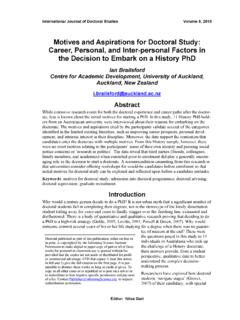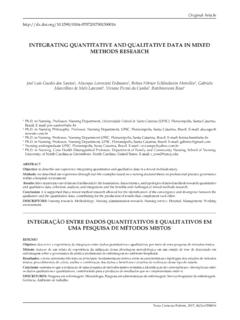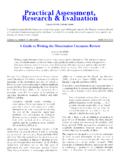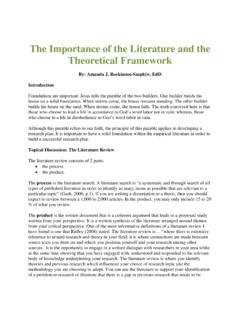Transcription of PhD THESIS ABSTRACT - Universitatea de Medicina …
1 UNIVERSITY OF MEDICINE AND PHARMACY CRAIOVA doctoral SCHOOL PhD THESIS ABSTRACT FEATURES OF URINARY TRACT INFECTIONS AT NEONATES, INFANTS AND TODDLERS SCIENTIFIC COORDINATOR: Professor MD PhD Florica POPESCU PhD CANDIDATE: Costin TEFAN CRAIOVA 2013 2 TABLE OF CONTENTS INTRODUCTION ..3 PART I THE STAGE OF KNOWLEDGE ..5 PART II PERSONAL CONTRIBUTIONS ..6 AIM OF THE STUDY. SET OBJECTIVES ..6 STUDY GROUP. PROCEDURE ..6 FINAL CONCLUSIONS ..18 KEY WORDS: urinary tract infection, predisposing factors, decisive features, morphological abnormalities 3 INTRODUCTION Urinary tract infections are inflammatory diseases of infectious etiology of urinary tract infection and / or renal interstitice. At newborn, infant and toddler up to 3 years, urinary tract infections are a major health problem, due to high incidence, sometimes unpredictable clinical course, the risk of possible complications, relapse and significant impact on renal function.
2 All these occur due to a nonspecific symptomatology and to an evolution under the guise of some comorbidities. At early ages, mostly, the first urinary infection remains undiagnosed, the pain being put under another diagnosis. The diagnostic and therapeutic approach of a urinary tract infection requires its recognition as a cause of disease, the promptitude and the accuracy of the diagnosis as well as the early institution of the treatment (Tullus, 2012). For the disease diagnosis as well as for the application of an early therapeutic plan, it is necessary a high index of suspicion, especially at newborns and infants. The late recognition of the condition and the complexity of the issues it raises from therapeutic point of view favour the installation and the progressive development of serious injuries, sometimes irreversible, in the renal parenchyma.
3 Given the fact that the symptoms and signs of urinary tract infection are not specific, but differ according to age, aetiology and the location of the infection, the aim of our study was to find the essential criteria to guide to early diagnosis of urinary tract infection at newborn, infant and toddler. In this respect, we proposed the achievement of several objectives, including the study of risk factors, the analysis of how it begins and of the correlation between the urinary tract infection and the dominant symptom, the fever, the related pathology study, the join of morphological abnormalities, the study of the recurrence and the appreciation of clinical and laboratory changes to argument and sustain the urinary tract infection diagnosis. The practical importance of the research has emerged as a result of the need to early detect a urinary tract infection, given the high morbidity, the etiologic 4 diversity and the possibility of chronic development, of relapse, increase the risk of permanent sequels, by affecting a growing organ the kidney.
4 Among the aspects with original character, the correlation of the urinary tract infection with several parameters (demographic, etiologic, clinical and functional) allowed to be established the extent to which their knowledge is useful for rapid diagnosis of the disease which, by the different response of the body to microbial aggression and the multiple incriminated predisposing factors, it manifests symptomatically or asymptomatically, located in the lower, upper ways or in the whole urinary tract and may have a unique acute evolution, recurrent, persistent or chronic. By the complexity of the issues highlighted, with therapeutic and prognostic implications, the results of our study are useful for the practicing physician and indicate the need for establishing some clear criteria of diagnosis and a closer monitoring of the patients with urinary tract infection.
5 The THESIS has 166 pages, 77 tables, 45 figures and 144 references. It is classically structured, into two parts: a first part, The stage of knowledge , consisting of three chapters, containing the data from the literature from the field and the second part Personal contribution , made of four chapters, in which the results of personal research are represented. The partial results of the study conducted during the four years have been presented at scientific meetings and events in the researched field and disseminated by the publication of three articles in relevant journals, indexed in international databases. For the support offered in making this THESIS , I want to thank the staff of the Pediatric Clinic of the Municipal Hospital, Craiova Philanthropy'', which allowed my clinical and paraclinical study of the hospitalized patients.
6 For the guidance and suggestions I have received throughout the period of making the research, I thank and present my best regards to Mrs. Florica Popescu, doctor university professor, the scientific leader of this THESIS . 5 PART I: THE STAGE OF KNOWLEDGE CHAPTER 1. Urinary tract infection. General aspects In this chapter we introduced synthetic data that contain the definition, the incidence and the classification of urinary tract infection, an inflammatory process of the urinary organs and / or of the renal interstitium, with a rising incidence at infants and toddlers. The term that certifies the infection by pyuria reveals the presence of a high number of polynuclear neutrophils in the urine, an expression of a process of defense against the infection, and the bacteriuria defines the presence of over 100,000 (105) viable bacteria / ml of urine, which indicates the infection (significant bacteriuria).
7 Both pyuria and bacteriuria are, however, value of symptom (Frederick et al., 2008). CHAPTER 2. Pathogenic and physiopathological aspects The chapter exposes modern concepts regarding the factors involved in the urinary tract infection (determinants, predisposing, of protection), the routes of infection of the urinary tract, the defence mechanisms, the bacterial colonization and the bacterial adhesion. The urinary infection does not occur necessarily once with the massive bacterial colonization of the urinary tract. The ability of bacteria to adhere or not to the urinary tract is one of the most important factors in the initiation of the urinary tract infection (Chang et al., 2006). The interpretation of the risk factors should take into account both the characteristics of the pathogen agent and the host area with which it comes into contact, therefore its susceptibility (Chon et al.)
8 , 2001). CHAPTER 3. Clinical and laboratory features The possibilities that the urinary tract infection is being clinically known are varied and often subtle. The clinical picture of the urinary tract infection at newborn, infant and toddler can take one of the following clinical forms: acute, recurrent, chronic - symptomatic or asymptomatic. The recurrent urinary tract infections or the reinfections are usually the privilege of small ages, mostly associated with malformative uropathies. Sometimes, however, they are not associated with malformative uropathies, taking the name of idiopathic recurrent urinary tract infections, commonly at girls (Dacher et al., 2004 Halek et al., 2010). 6 PART II. PERSONAL CONTRIBUTIONS AIM OF THE STUDY. SET OBJECTIVES The purpose of the study, motivated by the practical need to deepen the knowledge of etiologic, clinical, biological and imagistic order of the urinary tract infection, is to achieve the analysis of the utility of some criteria to guide more easily towards the diagnosis of urinary tract infection at newborn, infant and toddler, 0-3 years, in order to be treated appropriately, scientifically and early, to stop the progressive development of the disease to complications.
9 The main specific objectives of the study include: the identification of the predisposing risk factors (prenatal, postnatal), of the determinant factors and their correlation with several parameters (genre, age, area of origin); the assessment of the relationship between the prematurity and the urinary tract infection; the analysis of the onset way and the correlation between the urinary tract infection and the dominant symptom, the fever; the knowledge of the conditions associated to the urinary tract infection; the establishment of the relation between the location of the urinary tract infection and the inflammatory syndrome; the evaluation of the morphological recurrences and the abnormalities; the assessment of the present clinical and laboratory changes. THE STUDY GROUP. PROCEDURE We performed a retrospective study on a sample of 495 patients diagnosed with urinary tract infection, selected from a total of 12,551 patients hospitalized with general pathology, for a period of five years (2008-2012).
10 For the diagnosis of urinary tract infection, we took into consideration and used the clinical criterion as well as the laboratory criterion (the exam Urinalysis, bacteriuria and positive urine culture). The positive urine culture was the decisive argument of the diagnosis when the quantitative presence of the germs was greater than 105 colonies / ml. In our study there were not included the children whose urine culture was negative and showed no elements of pathological significance. 7 RESULTS In a first part of the results, we presented the study of the risk factors according to gender, age group and area of origin at patients with urinary tract infection and we analyzed then the relationship of this infection with prematurity. The prenatal factors have been identified in a number of 84 patients with urinary tract infection (Table 1).














